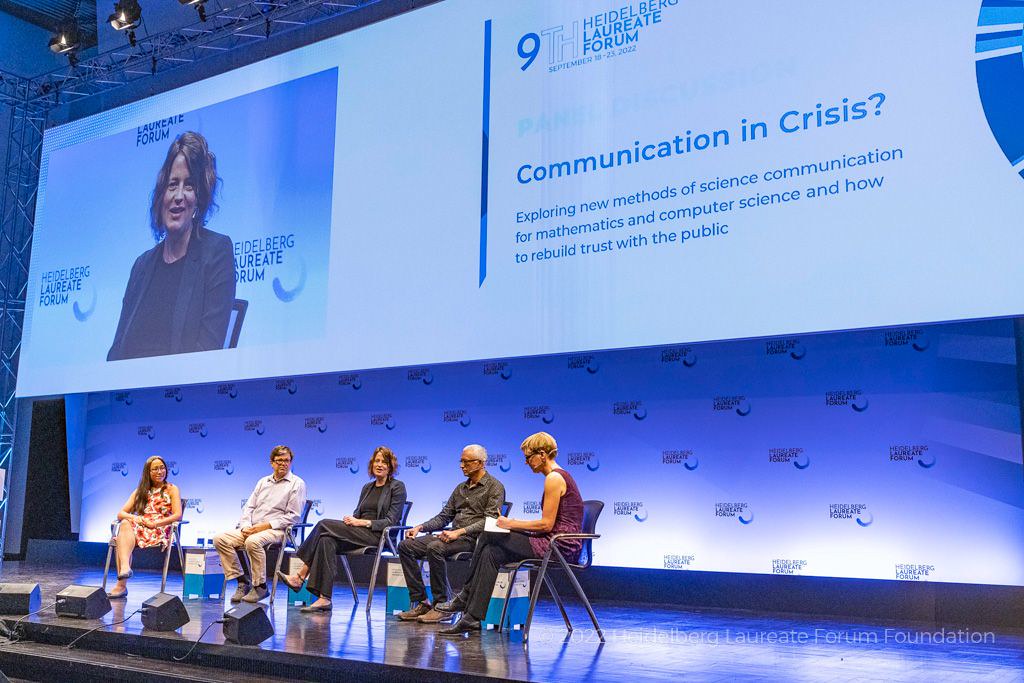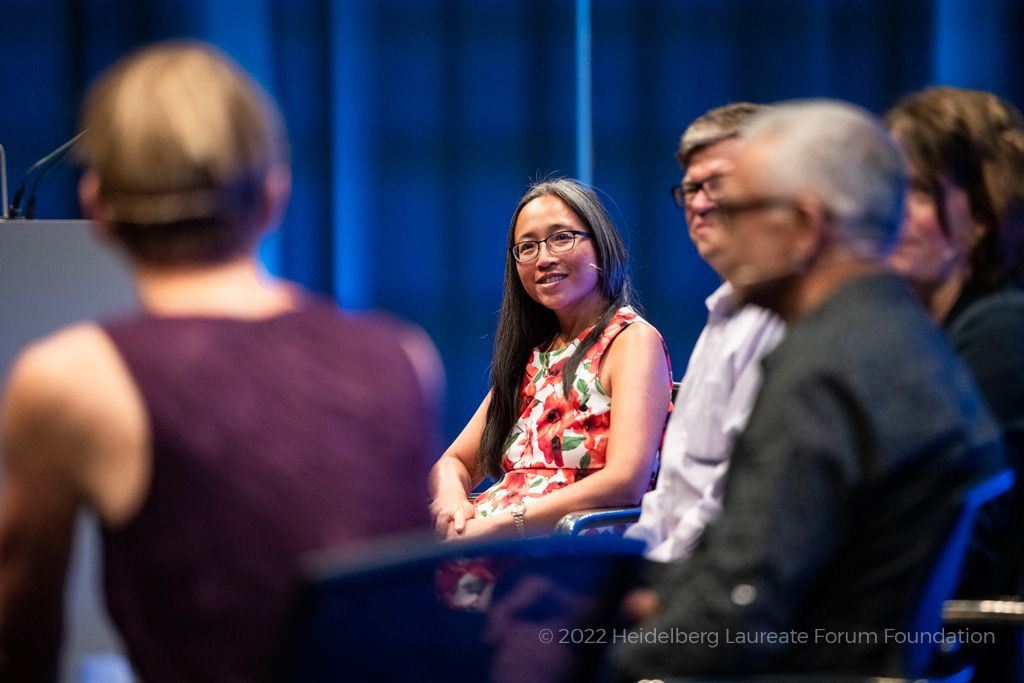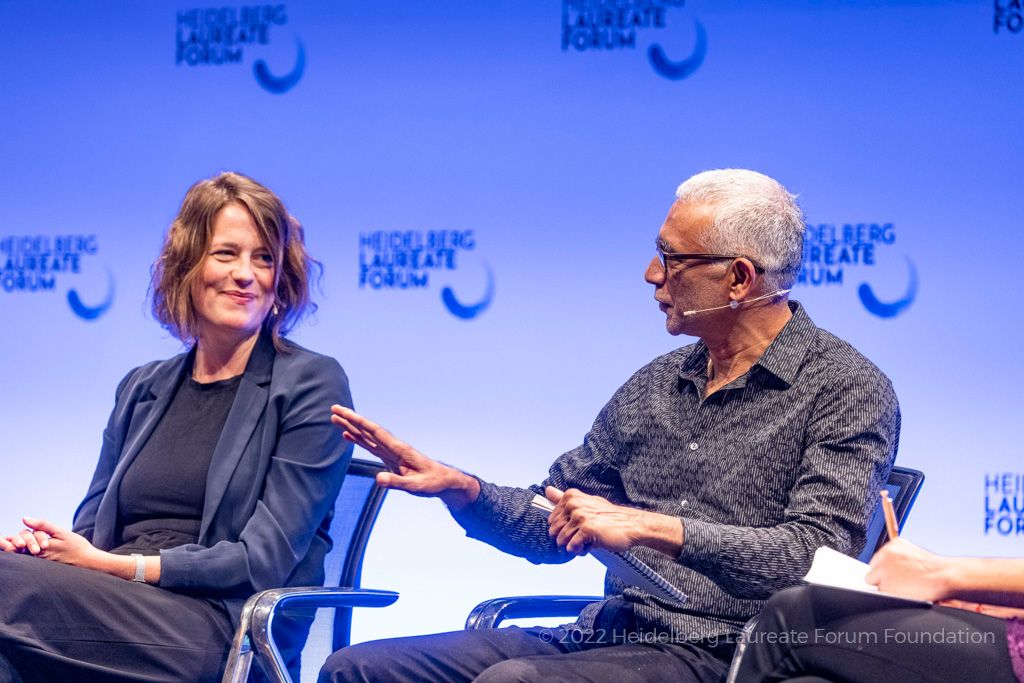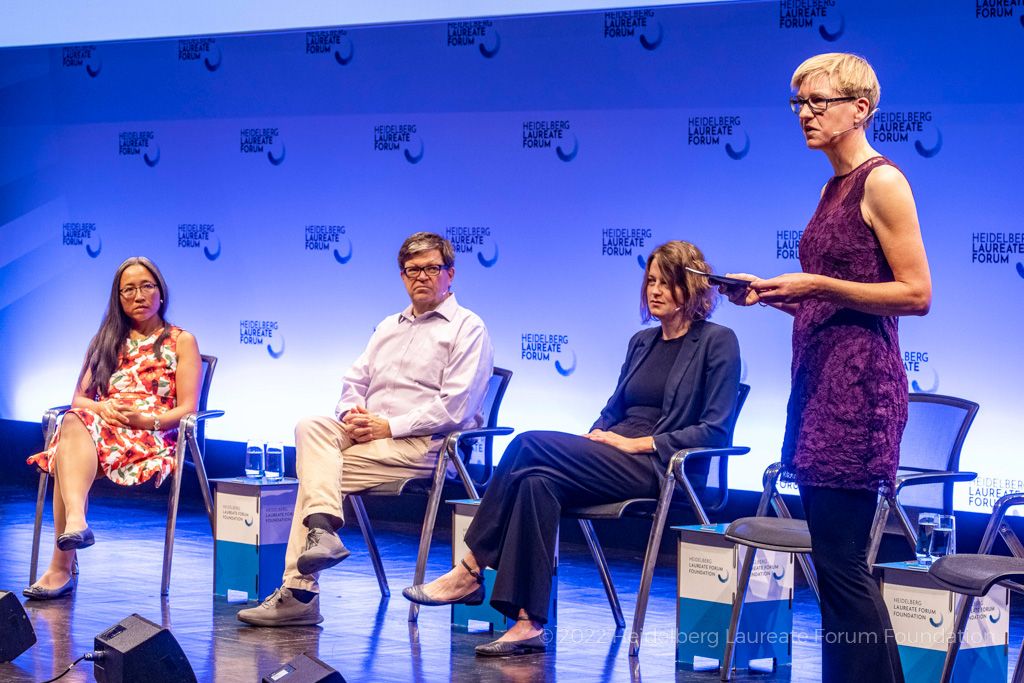A Discussion about Science Communication
Katie Steckles

© Heidelberg Laureate Forum Foundation / Flemming
At this year’s HLF, an important tradition has been continued. Alongside lectures from distinguished laureates and chances to share and discuss research in maths and computer science, time has been set aside to discuss a related issue: science communication.
In a world where maths and computer science underlie much of the technology and infrastructure we rely on every day, it’s important for people to have an understanding and appreciation of it – but it’s traditionally considered a very difficult subject to communicate effectively, especially at high levels.
To this end, a panel gathered on September 22 to consider questions like: How can maths and computer science be communicated in a way that sparks the public’s curiosity and interest? And, in this current age of skepticism and distrust of the scientific establishment, how can the scientific community and science journalism help counteract these trends, and help increase public trust?
Eugenia Cheng

Eugenia Cheng. © Heidelberg Laureate Forum Foundation / Flemming
First we were introduced to mathematician and concert pianist Eugenia Cheng, who’s also a maths communicator, YouTuber and author. Cheng describes her career as unusual – she was originally a tenured maths professor, “until I wasn’t.”
She started out making a successful series of YouTube videos on her favourite subject – category theory. Cheng became more well-known after being asked to write some promotional equations about clotted cream and jam on scones, the resulting media attention allowing her to build enough of a profile to start writing popular maths books, of which her eighth is out next month.
Her experience working at several institutions has shown her that maths communication is not sufficiently valued or supported within universities. The only place she’s worked where she felt it was properly valued was in her current post at the Art Institute in Chicago, where she teaches maths to art students. While they’re not necessarily inclined to love the subject, Cheng seeks to validate their past experiences with maths – which may have been traumatic – and to show them that maths can address the issues they care about.
She had a clear set of recommendations for how to improve maths communication, and they’re mainly about improving its profile as an activity. Maths communication is dismissed by institutions as unimportant or unnecessary, but Cheng deems it important that people at all levels, from primary school upwards, engage more with mathematics. This engagement doesn’t even necessarily need to be focused on proficiency in mathematics, but is about making sure everyone can follow scientific arguments and erase the false dichotomy between ‘maths people’ and ‘not maths people’.
Eugenia Cheng also believes proper career paths in science communication will help, and argued that all university maths and science departments should have a dedicated role for a communicator, at the level of a tenured professor. Science communication courses should be offered at university, and communication skills should be included in school science lessons.
But the most important goal she advocated for is making maths more inclusive – both on the level of increasing diversity in the field, but also aiming to value communication skills more: combating the notion that being brilliant and being incomprehensible are connected – she once heard a colleague say “Being good at teaching proves you are bad at research,” underlining the unhelpful position that the two are incompatible and placing more value on researchers being able to explain their work. She hopes this will lead to a shift in attitudes towards mathematics and science.
Yann LeCun
Yann LeCun, computer scientist and ACM AM Turing Laureate, addressed the question of the science communication crisis by asking ‘Are we really in a crisis, or just a transition period?’ Historically, every new communication technology from the printing press to the phone to TV has resulted in unrest, and the move to social media and internet communication has just meant another change in the way we communicate.
“Everyone has a voice now,” he explained, so those who don’t believe in science are much more vocal and prominent than they used to be. “What can carry information can also carry disinformation.” The public is bombarded with information, but without good training in how to discern the reliability of what we’re reading. He pointed out that the age group most likely to fall for misinformation online is the 65-year-old age category, and younger internet users are more likely to think before believing what they read. He thinks things will also improve as we figure out the best way to run a social network.
Overall, LeCun was positive about the state of science communication. Anyone can now access scientific information, even directly via websites like ArXiV, and scientists are active on social media sharing their work directly.
He acknowledged there were worries in the world today – climate change and threats to democracy – which might make people feel pessimistic and leave them wanting to question the source of this information in the hope it might be false. But to restore public trust, we needed to explain how science fundamentally works: it’s a process whereby we’re not always right the first time, and disproving our old theories is part of scientific discovery.
Anna Maria Hartkopf
Our next expert was a mathematician with a doctorate in science communication who has worked in various research departments and as a maths teacher, as well as writing a Handbook of Mathematical Science Communication. Anna Maria Hartkopf advocated for a scientific approach to science communication – researchers are constantly looking into the best ways to convey information and engage people with the subject. While there’s good integration with natural sciences, the research doesn’t have as much coverage in abstract sciences like maths and computer science – people communicating them are often detached from the discourse.
In her research lab at Freie Universität Berlin, she organises fellowships for science journalists to come and work with scientists to improve their communication. Abstract sciences are more difficult for journalists to cover, she argues, because they take more time to understand – you may need to interview a subject multiple times to be able to write about it well. Her research involves developing new communication formats – including visual and virtual media – and determining how effective they are.
Hartkopf described science journalism as ‘going through a bit of a hard time’: it’s easy for science news coming out of an institution to be “mixed up” in the detail of who’s communicating it, what their objectives are and why they’re telling us – whether it might be for personal gain or political reasons. And it’s reasonable for people to be sceptical, especially if that’s something we expect scientists to be, too. Generally though, she thinks trust in science is high – especially so in the wake of the Coronavirus pandemic, when science was an important tool to fight it.

Anna-Maria Hartkopf and Anil Ananthaswamy at the 9th Heidelberg Laureate Forum. © Heidelberg Laureate Forum Foundation / Flemming
Anil Ananthaswamy
Journalist and author Anil Ananthaswamy agreed that there’s a crisis in the way the public perceives science. But it’s not a crisis of communication – he argued that maths and science communication has been very good, especially over the last 10-15 years – he gave several examples of recent media that communicate science clearly and effectively.
He recommended Steven Strogatz’ book Infinite Powers, as well as Leonard Suskin’s ‘Theoretical Minimum’ books, which resulted from a series of lectures given to Silicon Valley professionals. He also cited several excellent mathematical YouTube channels and podcasts he sees as doing good work.
The crisis, he argued, is due to misinformation – it’s not that science communication isn’t trying. Now that technology allows misinformation to spread fast and wide, it needed to be combated with an institutional response. Scientific dissent and disinformation has always existed – he cited the tobacco lobbies, who tried to convince people smoking wasn’t harmful to health; it took serious work from investigative journalists to stop it. Nowadays, climate change denial and misinformation about COVID-19 has been spread for political gain, and a similar response is needed from the media.
Anil also made clear that there was an important distinction between science communication and science journalism. While both communicate scientific ideas, and need to do so clearly and engagingly, journalists have a responsibility to keep a distance from their sources and be objective. They can be on the side of science, but not on the side of scientists, and instead need to work for a general public good. Science communication, especially when undertaken by scientists themselves, has a fundamentally different approach, and this can result in adversarial situations at times.
Mathematical Misinformation
As the discussion continued, two main topics emerged from these initial introductory thoughts: the first was the issue of misinformation and anti-scientific sentiment, and how it could be countered. Two of the panelists had direct experience of this, and their stories were illuminating.
Cheng’s own experience with the mathematics of clotted cream showed her that untruths can often spread more quickly: the company who asked her to do the research produced a press release including the claim that she had proven the Cornish way of putting jam and cream on scones was better than the opposing Devonian ordering (a source of some controversy in the UK – some context here).
This wasn’t true, but her attempts to set the record straight (publishing a paper outlining her original findings) didn’t stop the story from becoming a controversial news item – the main result of this was that she had a bigger audience to explain mathematics to, but it was a harsh lesson in how incorrect information can be more enticing for news outlets to repeat.
Another area in which stories often get blown out of all proportion is in AI – a topic Yann LeCun has much experience of. His colleagues published some work in 2015 about two simple AIs they’d built with the goal of seeing if they could learn to work together on solving a problem. The two agents lived in a virtual environment and were given a particular task – one on which they would need to cooperate in order to solve it.
The environment was set up so the AIs could communicate in English – they were set up to use written language to send each other messages. Fascinatingly, the researchers found that they gradually started to use certain English words as shorthand for completely different concepts, and developed their own ‘language’ to communicate most efficiently about the problems they were working on.
The researchers couldn’t understand what the AIs were saying to each other without decoding the meaning. They theorised that because the two AIs had similar brain wiring in the way they were programmed, they could communicate more efficiently and naturally developed a mutual shared language – in the same way human twins often have their own secret ways of communicating.
While this was written up in the paper as an interesting unexpected outcome – the experiment was considered to have failed, but without any spectacular catastrophic outcome – journalists who found the research decided to present it as an overblown tale of science gone awry. The machines were learning and would take over and destroy us all, communicating in their own secret language and resulting in scenes from Terminator movies. The scientists had to write a blog post to explain and clarify that the experiment implied nothing nearly so dramatic and terrifying.
In both cases here, the science being done was correct, but the interpretation of the results by journalists or those with an agenda was incorrect. Cheng pointed out that wrong stories often get more clicks than correct ones – although LeCun (chief AI Scientist at Meta, who run Facebook) is keen to clarify that social media algorithms are better now at reducing the impact of ‘clickbait’ and the polarising effect that can be caused by algorithmic news feeds, which experiments have shown is negligible.
Communication Breakdown

From left to right: Eugenia Cheng, Yann LeCun, Anna-Maria Hartkopf and Eva Wolfangel. © Heidelberg Laureate Forum Foundation / Flemming
The other main thread in discussion was about how we communicate science – a big topic, since this happens at many levels and to different audiences. Hartkopf pointed out that many issues are caused by communication using a ‘Deficit Model’. This is based on the assumption that there’s a large gap between scientists and the rest of society – a gap in appreciation of science, and in scientific knowledge and understanding. Assuming a deficit results in communication that doesn’t engage people or make them feel included, and trust can be lost.
So how can we regain this trust? One major theme which came out echoed LeCun’s earlier point about communicating the way scientific discoveries are made, and being open about the fact that some theories might still be disproved – we’re in a constant process of learning, and scientific results are often communicated with a degree of uncertainty. But this is a fundamental part of science. Anil Ananthaswamy explained, “An honest scientist will say they don’t know – and readers should understand that’s ok and be comfortable with that.” Eugenia Cheng added, “We don’t run away from not understanding – we run into it. It’s what drives us.”
The investigative nature of science poses a few problems (and maths isn’t immune – even proven results only hold true within the framework they’re proven in). It leaves scientists vulnerable when they need to display uncertainty, and this can be frightening. If we overstate the certainty in our results, we might end up later going back on statements and undermining our authority as a source of facts. Cheng argued we should be talking more about uncertainty, and earlier in education, before it’s too late.
However, admitting that theories are theories opens us up to a different issue – Anna Maria Hartkopf pointed out that just because a scientific theory isn’t 100% true, doesn’t mean that all other theories, including ideas someone just came up with from nowhere, should carry equal weight. This leads back to the misinformation problem, and how artificial ‘balance’ can affect the perception of scientific consensus.
While such a short time would never be enough to discuss so many important and overlapping issues, overall the panel agreed that communicating science – whether it is by the media or by scientists – is important and difficult to get right. The science media has a responsibility to take details seriously, and tell the stories not just of the scientists but of their ideas.
Everyone trying to communicate science should remember it is easy to overestimate how much the audience knows and underestimate their intelligence. We should all remember to consider the audience we’re communicating to, as well as their cultural background and context, in order to be inclusive in how we communicate mathematics and science.
You can find the full video of the panel on the HLF YouTube Channel.
The post A Discussion about Science Communication originally appeared on the HLFF SciLogs blog.